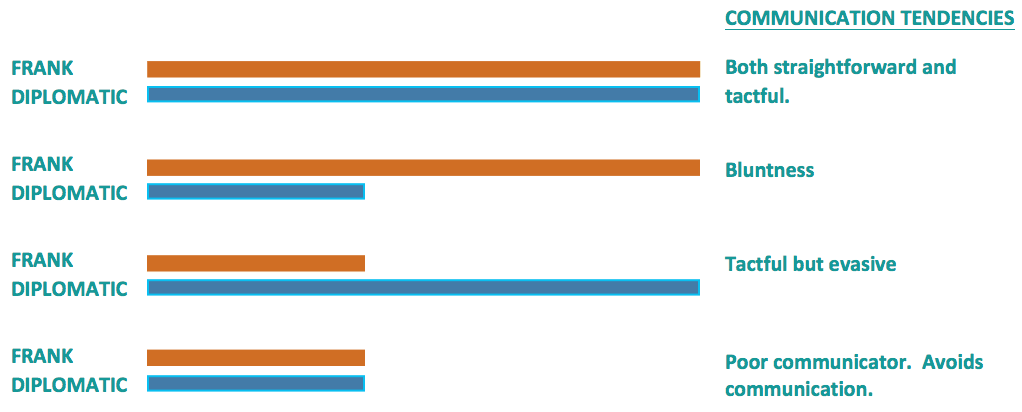Either-or thinking is a trap we can easily fall into that encourages us to believe there is only one right behavior and it blinds us to the opportunities of a more balanced, albeit more paradoxical, approach.
Life is full of light-hearted paradoxical sayings: slow down to speed up, tough love, stability through change, and more. Most leaders easily understand that these behaviors sound like opposites ends of a continuum but are really very complimentary. We know there can be great benefits in using “both” of these “opposites”.
Are you at risk with Either-Or thinking?
Take a moment to reflect and self-analyze on these typical activities you engage in at work:
When making decisions: is your approach 1) analytical, or 2) intuitive?
When planning strategy: are you more likely to 1) take risks, or 2) analyze pitfalls?
When driving performance: do you 1) hold others accountable, or 2) show compassion?
When communicating: are you 1) frank, or 2) diplomatic?
When delegating: are you 1) authoritative, or 2) collaborative?
When considering opinions: are you 1) certain, or 2) open/reflective?
Hopefully you answered these questions with some (1) AND some (2), indicating that you have balanced versatility – the ability to use either or both sets of behaviors at any moment in time, depending on what the situation calls for.
What gets in our way of having balanced versatility?
We often consider behaviors as bi-polar (either-or) – a continuum with one set of behaviors at one end, and the other set on the other end – believing that the behaviors are oppositional.

If you view Frank and Diplomatic on a singular continuum, as illustrated, you would conclude that the communication preference of an individual is either Frank (direct, to the point) or Diplomatic (tactful, considerate of receiver).
What are you risking?
We often see many other behaviors in our business environment on an ‘either-or’ scale, as well. An executive I worked with a few years back called people who operate in this way ‘one-trick ponies’ and I’ve seen far too many leaders struggle with the limitations of their either-or thinking.
- Impaired ability to create consensus and alignment. One plant manager who was strong in giving honest corrective feedback but could not disagree constructively with approaches or ideas he didn’t like. While his authoritative manner was appropriate for addressing safety risks, it was not effective for solving complex operational problems.
- Ineffectual sales and negotiation. A sales professional who responded diplomatically to every customer objection – price, delivery, terms – but could not say no to a customer. He wrote a lot of orders, but his numbers weren’t great at the end of the month. And his customers viewed him as weak – unable to advocate for them.
- Confusion. The manager who answered team member requests with one word: yes or no. She aced assertiveness, but without the ability to sense and attend to other’s needs, her power was diminished. Her yes and no answers were so austere, they left people affronted and confused.
One-trick ponies compromise their effectiveness by overusing their strengths to the exclusion of alternative (and more effective) behaviors required in many situations. Without access to the full complement of behaviors, their choices are limited, and so is their impact.
Learning from Paradox Theory
Dr. Dan Harrison conducted longitudinal research in behavioral preferences and patterns and developed the Paradox Theory (Harrison Assessments Int’l Limited, 2007 – 2018). He found that the bi-polar scale falsely assumes either-or relationships between traits that are complementary. These traits are not on opposite ends of a single scale, but are rather separate scales. Removing the either-or paradigm allows for possibilities that an individual can be strong in both complementary traits, in either trait, or in neither trait, and each combination results in different behavioral tendencies. Let’s reconsider the Frank /Diplomatic traits in a complementary context and the communication styles resulting from these combinations.

From this illustration we can draw a couple of conclusions:
- Balanced versatility – strength in both complementary traits – provides a bigger reservoir of behavioral options and enables a leader to choose the approach, style, and tone that is situationally appropriate.
- Behaviors which are often perceived as strengths (e.g. diplomacy) are likely to become a weakness when the complementary balance is missing.
What does this mean for YOUR leadership style?
We often have blind spots when it comes to complementary skills as we tend to see our best skills as strengths. But, when over-used, these strengths become a weakness, and potentially de-rail us from achieving our potential.
Ask yourself what situations are challenging to you, and leave you feeling so-so? It’s a good place to start observing where you have an either-or perspective and to begin developing complementary strengths. It will give you access to new ways of thinking and acting in those challenging situations, and develop your versatility to respond according to what each situation needs.
At Kinetic Insights, our PathFinders are skilled in helping leaders unleash the greatness in themselves and in their organizations. Call or email us for a quick discussion that just might put you and your team on the path to significant change.











Leave A Comment